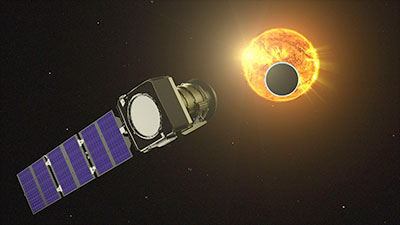NASA's Pandora Mission One Step Closer To Probing Alien AtmospheresPandora, NASA's newest exoplanet mission, is one step closer to launch with the completion of the spacecraft bus, which provides the structure, power, and other systems that will enable the mission to carry out its work.

Above: An artist's concept of the Pandora mission, seen here without the thermal blanketing that will protect the spacecraft, observing a star and its transiting exoplanet. (NASA's Goddard Space Flight Center/Conceptual Image Lab)
"This is a huge milestone for us and keeps us on track for a launch in the fall," said Elisa Quintana, Pandora's principal investigator at NASA's Goddard Space Flight Center in Greenbelt, Maryland. "The bus holds our instruments and handles navigation, data acquisition, and communication with Earth — it's the brains of the spacecraft."
Pandora, a small satellite, will provide in-depth study of at least 20 known planets orbiting distant stars in order to determine the composition of their atmospheres — especially the presence of hazes, clouds, and water. This data will establish a firm foundation for interpreting measurements by NASA's James Webb Space Telescope and future missions that will search for habitable worlds.
"We see the presence of water as a critical aspect of habitability because water is essential to life as we know it," said Goddard's Ben Hord, a NASA Postdoctoral Program Fellow who discussed the mission at the 245th meeting of the American Astronomical Society in National Harbor, Maryland. "The problem with confirming its presence in exoplanet atmospheres is that variations in light from the host star can mask or mimic the signal of water. Separating these sources is where Pandora will shine."
Funded by NASA's Astrophysics Pioneers program for small, ambitious missions, Pandora is a joint effort between Lawrence Livermore National Laboratory in California and NASA Goddard.
"Pandora's near-infrared detector is actually a spare developed for the Webb telescope, which right now is the observatory most sensitive to exoplanet atmospheres," Hord added. "In turn, our observations will improve Webb's ability to separate the star's signals from those of the planet's atmosphere, enabling Webb to make more precise atmospheric measurements."

Above: Pandora's spacecraft bus was photographed Jan. 10 within a thermal-vacuum testing chamber at Blue Canyon Technologies in Lafayette, Colorado. The bus provides the structure, power, and other systems that will enable the mission to help astronomers better separate stellar features from the spectra of transiting planets. (NASA/Weston Maughan, BCT)
Astronomers can sample an exoplanet's atmosphere when it passes in front of its star as seen from our perspective, an event called a transit. Part of the star's light skims the atmosphere before making its way to us. This interaction allows the light to interact with atmospheric substances, and their chemical fingerprints — dips in brightness at characteristic wavelengths — become imprinted in the light.
But our telescopes see light from the entire star as well, not just what's grazing the planet. Stellar surfaces aren't uniform. They sport hotter, unusually bright regions called faculae and cooler, darker regions similar to sunspots, both of which grow, shrink, and change position as the star rotates.
Using a novel all-aluminum, 45-centimeter-wide (17 inches) telescope, jointly developed by Livermore and Corning Specialty Materials in Keene, New Hampshire, Pandora's detectors will capture each star's visible brightness and near-infrared spectrum at the same time, while also obtaining the transiting planet's near-infrared spectrum. This combined data will enable the science team to determine the properties of stellar surfaces and cleanly separate star and planetary signals.
The observing strategy takes advantage of the mission's ability to continuously observe its targets for extended periods, something flagship missions like Webb, which are in high demand, cannot regularly do.
Over the course of its year-long prime mission, Pandora will observe at least 20 exoplanets 10 times, with each stare lasting a total of 24 hours. Each observation will include a transit, which is when the mission will capture the planet's spectrum.
Pandora is led by NASA's Goddard Space Flight Center. Lawrence Livermore National Laboratory provides the mission's project management and engineering. Pandora's telescope was manufactured by Corning and developed collaboratively with Livermore, which also developed the imaging detector assemblies, the mission's control electronics, and all supporting thermal and mechanical subsystems. The infrared sensor was provided by NASA Goddard. Blue Canyon Technologies provided the bus and is performing spacecraft assembly, integration, and environmental testing. NASA's Ames Research Center in California's Silicon Valley will perform the mission's data processing. Pandora's mission operations center is located at the University of Arizona, and a host of additional universities support the science team.













